If you’re looking to upgrade your home entertainment with smart IR blaster hubs in 2025, I’ve tested some excellent options like BroadLink, MOES, and others, which support extensive device compatibility, easy setup, and reliable Wi-Fi connection. These hubs can control TVs, air conditioners, curtains, and more, often integrating with voice assistants. Many offer scene creation and automation, making them a smart addition to your setup. Keep exploring to find out which hub best fits your needs.
Key Takeaways
- Compatibility with over 50,000 IR devices ensures broad support for TVs, air conditioners, and media equipment.
- Easy setup with dedicated apps, learning functions, and scene creation simplifies device integration and automation.
- Supports major voice assistants like Alexa and Google Assistant for hands-free control of entertainment systems.
- Reliable Wi-Fi connectivity on 2.4 GHz networks and strong IR emission ensure effective control across rooms.
- Advanced automation features, including scene customization and platform integrations, enhance home entertainment management.
IR Emitter Extender Cable, 10 Feet (3 M)
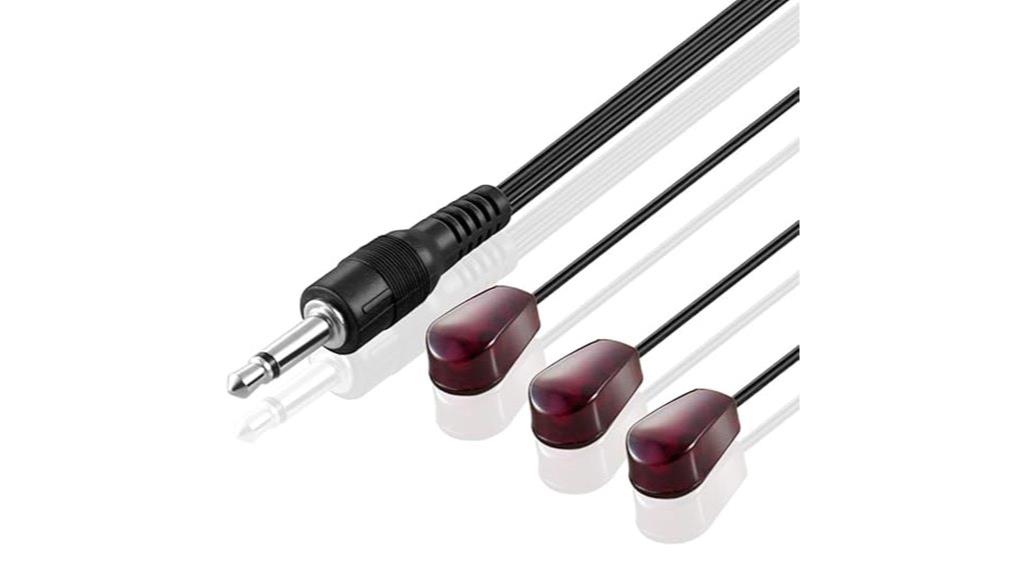
If you’re looking to control your hidden devices effortlessly, the IR Emitter Extender Cable, 10 Feet (3 M), is a must-have. This cable extends IR signals up to 10 feet, allowing me to operate devices behind cabinets or out of sight. Its compatibility with 38kHz devices, like Xbox One and AV equipment, ensures seamless control. The 3-eye 3.5mm jack makes setup simple, and the adhesive backing lets me mount it securely wherever needed. With this extender, I can manage multiple electronics remotely without fuss, making my home entertainment system more convenient and clutter-free.
Best For: those looking to remotely control hidden or out-of-sight electronic devices such as Xbox One, AV equipment, and home theater systems with extended IR signal reach.
Pros:
- Extends IR signals up to 10 feet for greater remote control flexibility
- Compatible with 38kHz frequency devices, ensuring broad device compatibility
- Comes with adhesive backing for easy and secure mounting on various surfaces
Cons:
- Limited to devices operating at 38kHz, not universal for all IR devices
- Requires an IR repeater kit or system to function effectively
- May need careful positioning for optimal IR signal transmission
BroadLink IR/RF Smart Home Hub for Home Automation

The BroadLink IR/RF Smart Home Hub stands out as an ideal choice for those looking to automate a wide range of IR and RF devices, from TVs and air conditioners to motorized curtains and projectors. It supports over 50,000 IR devices and RF gadgets within 433MHz, excluding rolling code systems. The hub integrates seamlessly with Alexa, Google Assistant, and Apple Siri, enabling voice control. While setup is straightforward, Wi-Fi connection issues can occur, especially with certain routers. It requires a 2.4GHz network and offers manual IR learning, but RF control is limited for some motorized or encrypted devices. Overall, it’s a versatile, affordable hub with some compatibility caveats.
Best For: users seeking an affordable, versatile IR/RF smart home hub to automate a wide range of devices with voice control and scene automation.
Pros:
- Supports over 50,000 IR devices and RF gadgets within 433MHz (excluding rolling codes).
- Seamless integration with Alexa, Google Assistant, and Apple Siri for voice commands and routines.
- User-friendly setup with learning buttons and routine/scene customization capabilities.
Cons:
- Limited RF control for motorized or encrypted devices, and some compatibility issues with certain remotes and device types.
- Wi-Fi connection can be unreliable with some routers, requiring firmware updates or router adjustments.
- Does not support 5GHz Wi-Fi, which may impact network flexibility and stability.
Broadlink RM4 Mini Smart Remote (2.4GHz Wi-Fi) IR Blaster Hub for Smart Home Automation
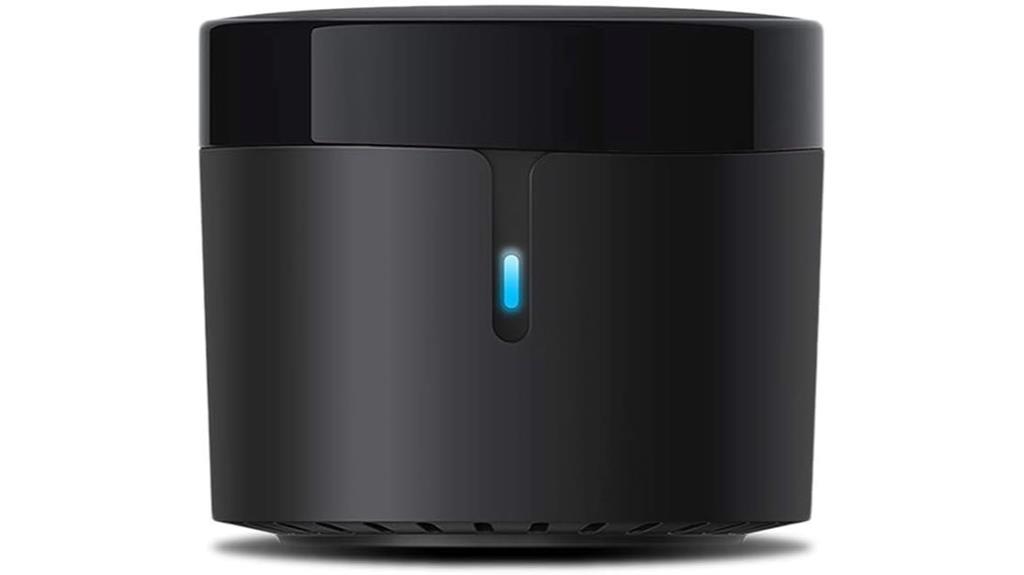
For anyone looking to expand their smart home setup with reliable IR control, the Broadlink RM4 Mini stands out thanks to its extensive device support and easy integration. It supports over 50,000 IR devices, including TVs, air conditioners, soundbars, and more, with a constantly updated cloud library. Control is simple via the free app or voice assistants like Alexa, Google, and Siri. You can create timers, scenes, and automate routines effortlessly. Just verify your Wi-Fi is 2.4GHz and within line of sight, as it doesn’t support RF or 5GHz networks. It’s a straightforward, versatile hub to enhance your home entertainment and automation.
Best For: Smart home enthusiasts seeking a reliable IR hub to control a wide range of devices through easy app and voice command integration.
Pros:
- Supports over 50,000 IR devices with a continuously updated cloud library.
- Compatible with popular voice assistants like Alexa, Google Assistant, and Siri for hands-free control.
- Easy setup with timers, scenes, and automation features to enhance home convenience.
Cons:
- Only controls IR devices; does not support RF or 5GHz Wi-Fi networks.
- Requires clear line of sight for IR signals; obstacles can disrupt performance.
- No included power adapter; users must provide their own 5V 1A power supply.
MOES WiFi Smart IR Remote Controller for Smart Home
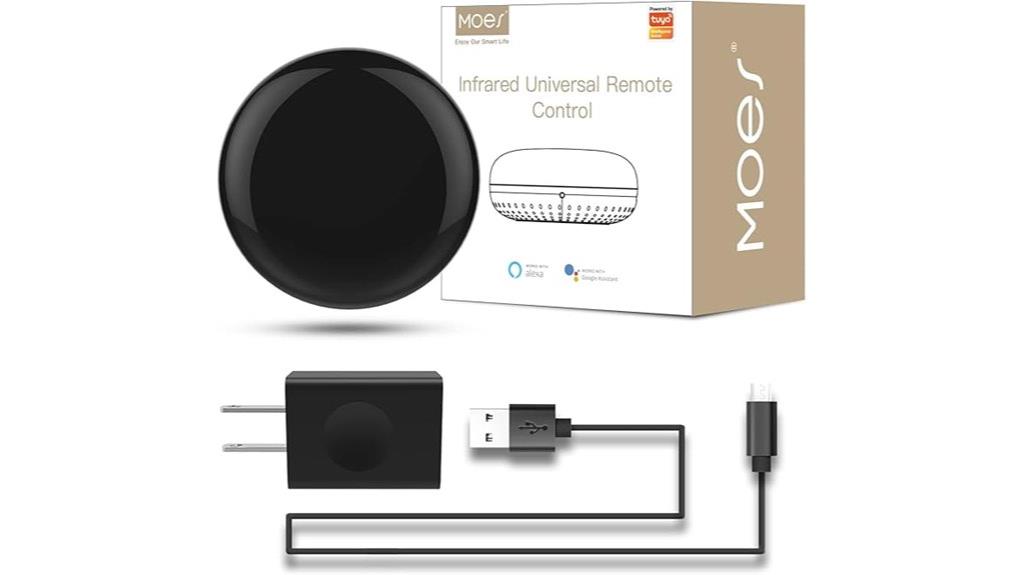
Looking to simplify control over multiple infrared devices in your smart home? The MOES WiFi Smart IR Remote Controller is a versatile, all-in-one solution. It works with air conditioners, TVs, fans, and more, using IR signals at 38KHz. You can control devices remotely via the free Smart Life or Tuya app from anywhere. Plus, it supports voice commands through Alexa and Google Assistant for hands-free operation. The device includes DIY learning to copy signals from your original remotes, expanding compatibility. Just keep in mind, IR signals don’t penetrate walls, so placement within line of sight is essential. It’s a practical upgrade for seamless device management.
Best For: homeowners seeking an easy, versatile solution to remotely control multiple infrared devices like air conditioners, TVs, and fans through WiFi and voice commands.
Pros:
- Supports control of multiple IR appliances with a single device, simplifying home automation.
- Compatible with Alexa and Google Assistant for convenient voice control.
- Includes DIY learning feature to expand device compatibility by copying signals from original remotes.
Cons:
- Infrared signals cannot penetrate walls, requiring line-of-sight placement.
- Only supports 2.4G WiFi networks, limiting compatibility with some networks.
- Compatibility verification for specific brands/devices must be done via app or documentation, which may require some setup effort.
2022 WiFi All-in-One Control Hub with Infrared Gateway
https://m.media-amazon.com/images/I/71okATiWNrL._AC_SX679_.jpg
If you’re seeking a compact, all-in-one control hub that seamlessly integrates infrared and Wi-Fi devices, the 2022 WiFi All-in-One Control Hub stands out as an ideal choice. Its UFO-shaped remote and rounded design make it both stylish and easy to handle. It supports 2.4G Wi-Fi and offers 360° omni-directional infrared control within 10 meters, covering over 8,000 brands. No batteries are needed, and its infrared transmission material guarantees better responsiveness and penetration. Compatible with Alexa and Google Home, it allows voice commands and scene automation. This hub makes managing your smart devices straightforward, reliable, and integrated, perfect for enhancing your home entertainment setup.
Best For: smart home enthusiasts seeking a compact, easy-to-use hub that integrates infrared and Wi-Fi devices for seamless control and automation.
Pros:
- Supports 2.4G Wi-Fi and extensive infrared control over 8,000 brands.
- Compatible with Alexa and Google Home for hands-free voice commands.
- No batteries required, with a stylish UFO-shaped design and enhanced infrared transmission material.
Cons:
- RF control capabilities are not included or supported.
- Limited control area of less than 16m², which may not suit larger spaces.
- Additional RF devices are not included, requiring separate purchase for RF functionality.
MoesGo WiFi IR Control Hub for Smart Appliances
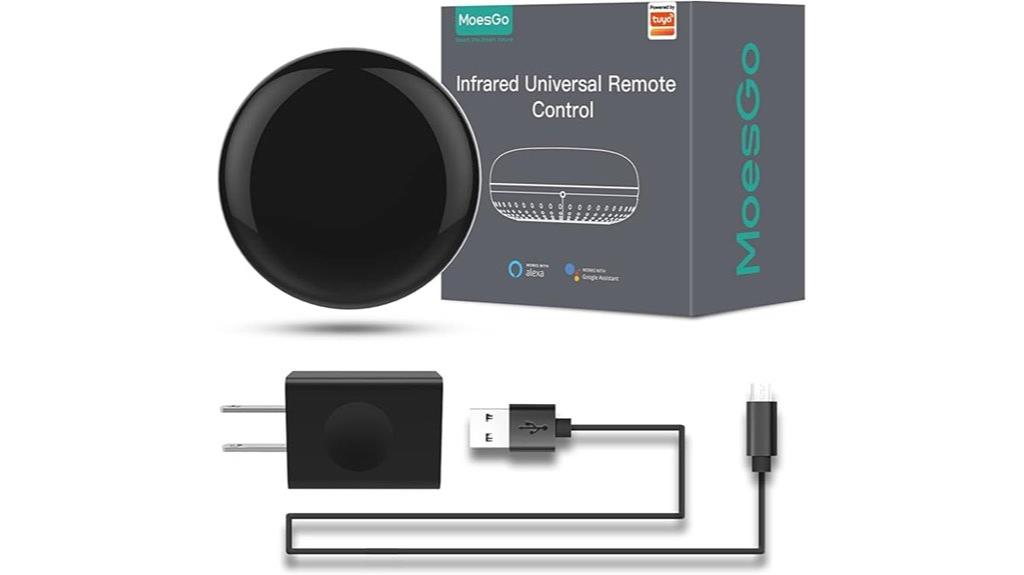
The MoesGo WiFi IR Control Hub stands out as an ideal choice for those seeking reliable voice and remote control of their home appliances through a single device. It supports devices like air conditioners, TVs, fans, media players, and set-top boxes via IR (38K Hz), using the Smart Life/Tuya app. You can control everything remotely from your smartphone or with voice commands through Alexa or Google Home. Plus, the DIY feature learns commands from your original remotes, expanding control options. It comes with a USB cable and US adapter, perfect for single-room setups. A two-year warranty and 60-day refund guarantee add peace of mind.
Best For: homeowners seeking a versatile, easy-to-use device to remotely and voice-control multiple IR-compatible home appliances within a single room.
Pros:
- Supports a wide range of IR devices including air conditioners, TVs, fans, and media players via the Smart Life/Tuya app
- Enables hands-free voice control through Amazon Alexa and Google Home for convenient operation
- Features a DIY copy function to learn and control devices with original remotes, expanding customization options
Cons:
- Only supports IR devices at 38K Hz; RF control is not included
- Designed primarily for single-room use due to IR line-of-sight limitations
- Operates exclusively on 2.4G Wi-Fi networks, which may restrict compatibility with some networks
SwitchBot Hub Mini Smart Remote, WiFi IR Blaster for TV & Air Conditioner
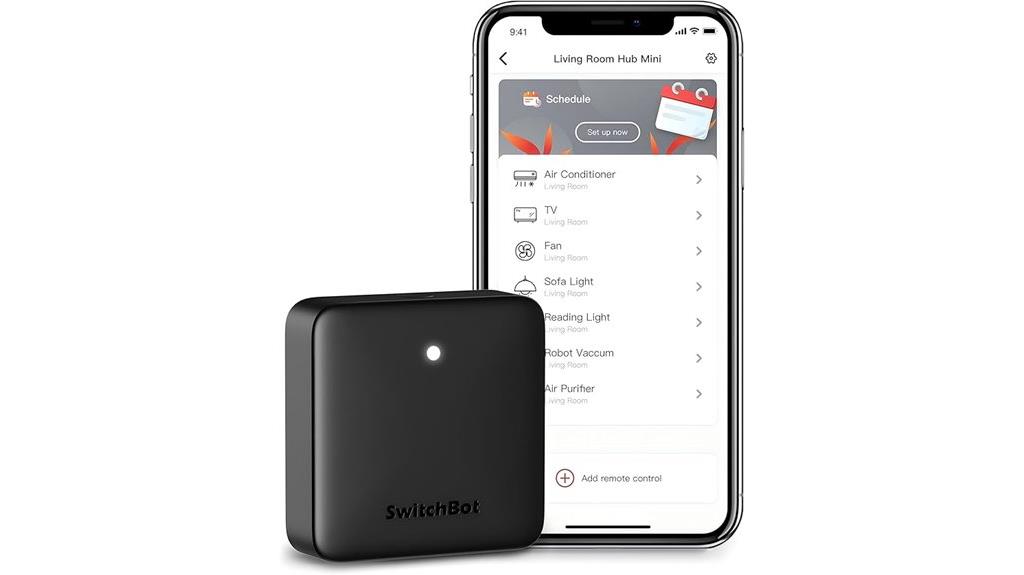
For those seeking an affordable and straightforward way to bring their existing IR devices into a smart home ecosystem, the SwitchBot Hub Mini Smart Remote stands out as an excellent choice. This compact, USB-powered IR blaster supports a wide range of devices like TVs, air conditioners, and soundbars, and connects via Wi-Fi for easy control. It works with Alexa, Google Assistant, Siri, and IFTTT for voice commands. Setup is quick through the SwitchBot app, and its learning mode lets you mimic existing remotes within seconds. While its interface is somewhat outdated and customization options limited, it’s a reliable, simple solution for automating basic IR appliances.
Best For: users seeking an affordable, easy-to-set-up IR remote control solution for basic smart home automation of TVs, air conditioners, and sound systems.
Pros:
- Simple and quick setup via the SwitchBot app with easy learning mode
- Compatible with popular voice assistants like Alexa, Google Assistant, Siri, and IFTTT
- Compact, portable design that easily integrates into various home environments
Cons:
- Outdated app interface with limited customization options for remotes and buttons
- Limited device compatibility, especially with complex or older IR remotes or multi-command devices
- Response times can be sluggish, and the database of supported remotes is not comprehensive
WiFi IR Blaster, Universal Remote Control Hub for Home Automation

A WiFi IR Blaster stands out as an ideal choice for those seeking seamless, centralized control over multiple home appliances. It supports 2.4G WiFi and works with IFTTT, making automation easy. The device controls infrared appliances like TVs, air conditioners, fans, and projectors with 360° signal coverage, ensuring no dead angles. You can operate it remotely via the Tuya Smart APP, customize controls, and even learn commands for unlisted devices. Plus, it supports voice commands through Alexa, Google Assistant, and other smart speakers. Designed for single-room use, it’s perfect for simplifying household device management and integrating smart home routines.
Best For: individuals seeking a centralized, easy-to-use solution to control multiple infrared home appliances with voice commands and automation capabilities.
Pros:
- Supports 2.4G WiFi and integrates with IFTTT for advanced automation routines.
- Provides 360° infrared signal coverage with no dead angles, ideal for single-room setups.
- Compatible with major voice assistants like Alexa and Google Assistant for hands-free control.
Cons:
- Designed for single-room use; infrared signals cannot penetrate walls, limiting coverage.
- Only supports IR (38kHz); RF devices are not compatible.
- Requires a stable WiFi connection and may need manual setup for devices not in the database.
Tuya Smart Zigbee IR Remote Controller, Infrared Universal Remote/IR Blaster
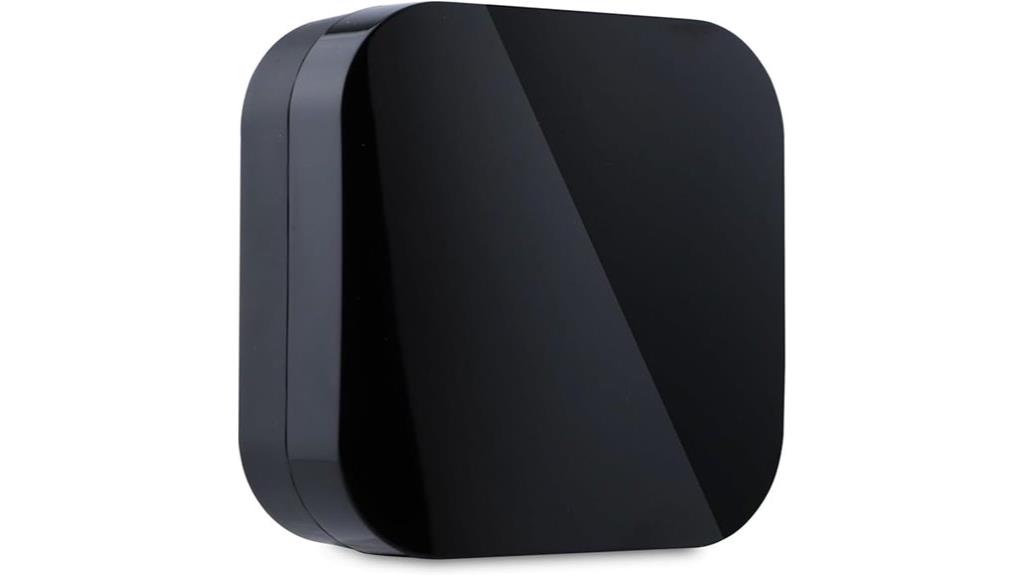
If you’re looking to seamlessly control multiple infrared devices in your home or office, the Tuya Smart Zigbee IR Remote Controller stands out as a versatile choice. It supports over 5,000 cloud IR codes, letting you manage TVs, air conditioners, DVD players, and more within at least 10 meters. Compatible with Alexa and Google Assistant, it offers voice control, while the Tuya and Smart Life apps enable remote management. It requires a zigbee wired gateway and 2.4 GHz WiFi, with no support for 5 GHz networks. The device also features DIY functions, device sharing, and group control, making automation simple and customizable.
Best For: homeowners, hotel managers, and office users seeking an easy, customizable way to control multiple IR devices through Zigbee integration and voice commands.
Pros:
- Supports over 5,000 cloud IR codes for wide device compatibility
- Compatible with Alexa and Google Assistant for voice control
- Allows DIY customization, IR learning, and device sharing for personalized automation
Cons:
- Requires a zigbee wired gateway, not compatible with wireless zigbee hubs
- Does not support 5 GHz WiFi networks, needing 2.4 GHz only
- Needs 2AA batteries, which may require frequent replacement
eRemote HA Wi-Fi IR Universal Remote Control for TV, Aircon, STB
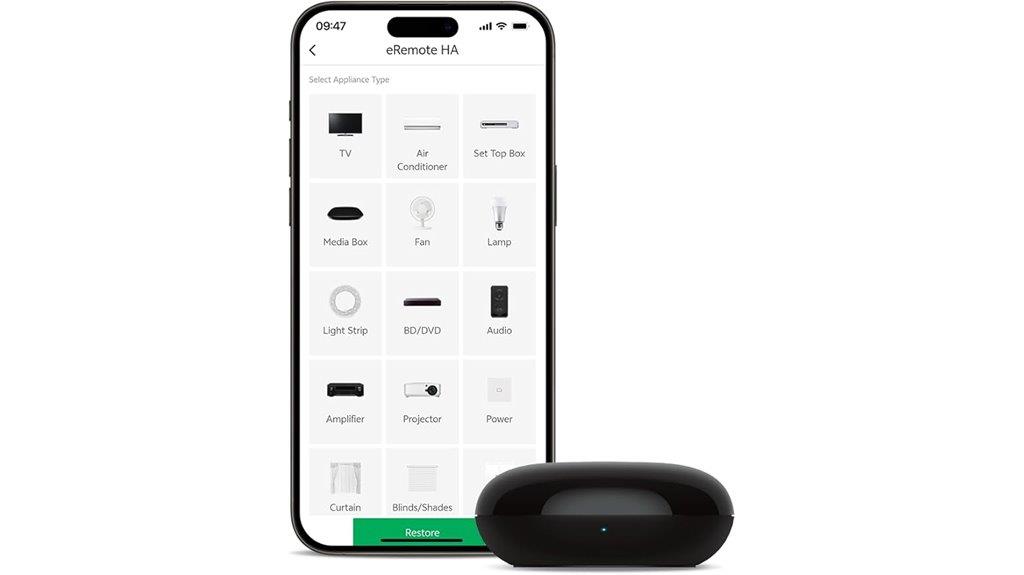
The eRemote HA Wi-Fi IR Universal Remote Control stands out as an ideal choice for tech-savvy homeowners looking to streamline their entertainment setup. It turns your smartphone into a powerful remote that supports over 22 device categories, including TVs, air conditioners, and set-top boxes, covering thousands of brands and models. Compatible with Alexa and Google Home, it offers voice control, and its 2.4GHz Wi-Fi ensures reliable connectivity. With a compact design and easy setup, it allows you to replace multiple remotes with a single app, making your home smarter and more organized. Despite some setup quirks, it’s a versatile and cost-effective solution for modern IR automation.
Best For: tech-savvy homeowners seeking to streamline their entertainment setup by replacing multiple remotes with a single, versatile app that integrates with smart home systems.
Pros:
- Supports over 22 device categories and thousands of brands and models for comprehensive coverage.
- Compatible with Alexa and Google Home for voice control, enhancing convenience.
- Easy-to-use app for remote learning and manual programming, enabling customization.
Cons:
- Setup can be complex and time-consuming, with some users experiencing connection issues.
- Limited device support and reliance on firmware updates for new device compatibility.
- App interface may be unintuitive, and firmware management can be cumbersome.
BroadLink RM4 Mini IR Universal Remote Control
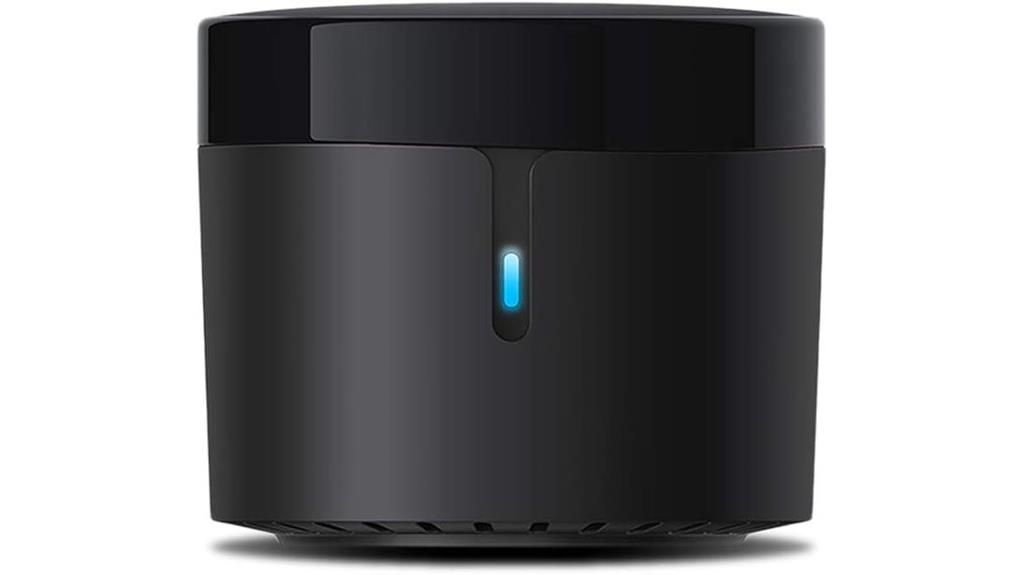
BroadLink RM4 Mini IR Universal Remote Control stands out for anyone seeking a versatile and easy-to-setup hub that supports over 50,000 IR devices, including TVs, air conditioners, and media players. It works via the BroadLink app, available on iOS and Android, with straightforward setup and scene creation. While limited to 2.4 GHz Wi-Fi, it doesn’t support Bluetooth or RF devices. You can program new devices or learn buttons if needed. Compatible with Alexa and Google Home, it offers voice control and integrates seamlessly into smart home setups. Plus, support for external sensors and FastCon technology makes it a flexible, user-friendly option for upgrading your entertainment system.
Best For: those seeking a versatile, easy-to-setup IR remote control hub compatible with a wide range of household devices and integrated with smart home voice assistants.
Pros:
- Supports over 50,000 IR-controlled devices, including TVs, air conditioners, and media players.
- Easy setup via the BroadLink app with scene creation and cloud database updates.
- Compatible with Alexa and Google Home for seamless voice control and smart home integration.
Cons:
- Limited to 2.4 GHz Wi-Fi networks; does not support 5 GHz or Bluetooth/RF devices.
- Requires unobstructed line-of-sight for optimal IR signal reception.
- External sensors and FastCon devices are sold separately, adding to overall cost.
WiFi Smart IR RF Blaster, Remote Control Hub
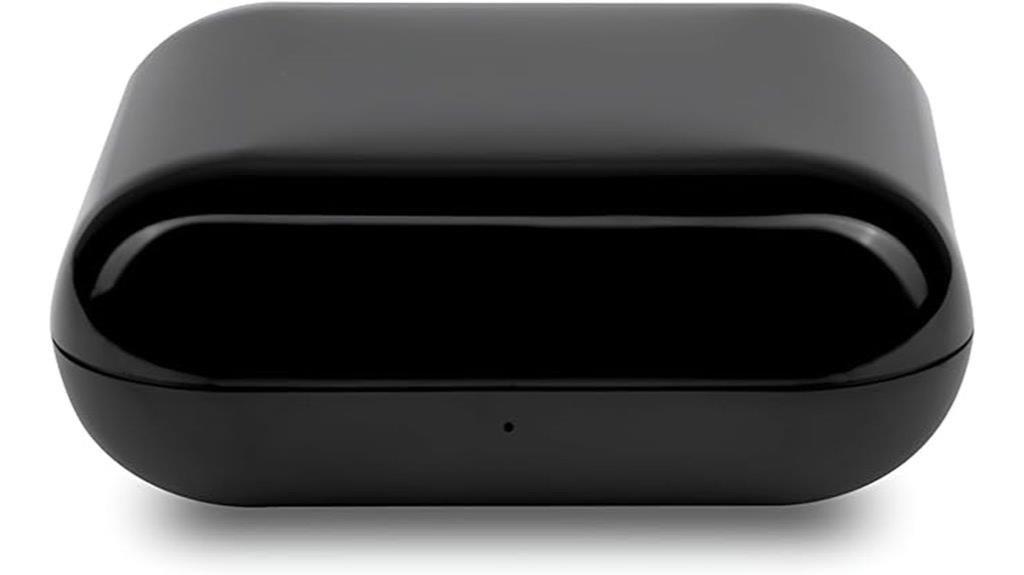
For those seeking versatile home automation, the WiFi Smart IR RF Blaster stands out by supporting both infrared and RF device control through a single hub. It works with the Tuya/Smart Life app, Alexa, and Google Home, letting you manage over 50,000 devices, including TVs, air conditioners, and RF-controlled curtains or garage doors. With an operating range up to 100 feet, it offers scene linkage and DIY programming to copy remote functions. However, setup can be tricky, especially with WiFi connection issues and limited compatibility. Despite some drawbacks, this hub provides a convenient way to unify your IR and RF devices in one smart system.
Best For: smart homeowners looking to centralize control of a wide variety of IR and RF devices within a single, app-controlled hub for enhanced automation and convenience.
Pros:
- Supports over 50,000 infrared and RF devices, including TVs, air conditioners, and garage doors.
- Compatible with popular voice assistants like Alexa and Google Home, enabling hands-free control.
- Offers scene linkage and DIY programming for customized automation and device copying.
Cons:
- Setup can be complicated, with frequent WiFi connection issues reported by users.
- Limited device compatibility and customization options in the app may restrict user experience.
- Short cables and the need for precise device alignment can make installation and use challenging.
WiFi IR Universal Remote, Smart Home Infrared Remote Blaster
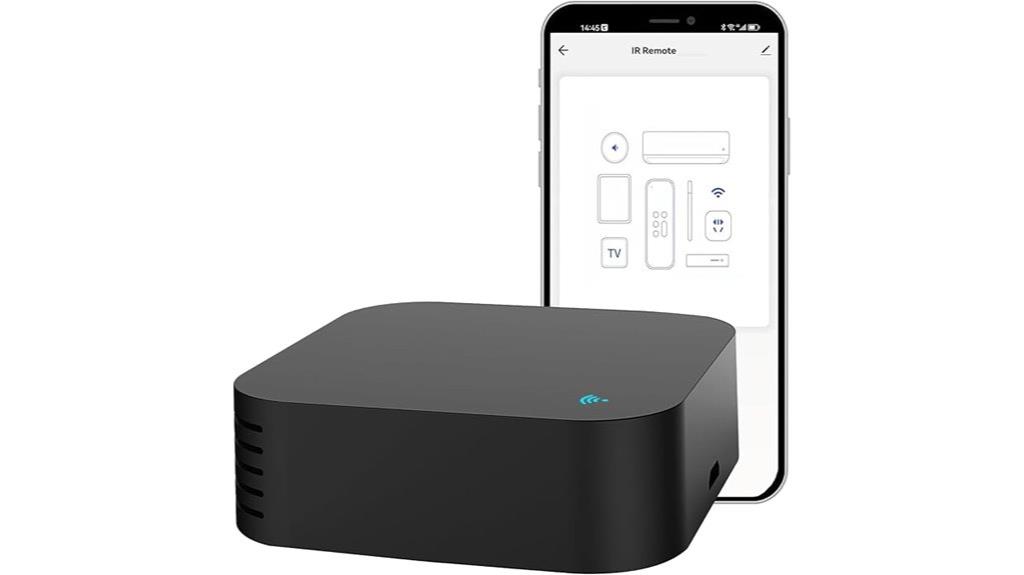
If you want a versatile remote that transforms your smartphone into a universal controller, the WiFi IR Universal Remote, also known as the Smart Home Infrared Remote Blaster, is an excellent choice. It supports over 50,000 IR devices, including TVs, A/C units, fans, and more, with a constantly updated cloud library. Connecting via WiFi, it works with the Tuya/Smart Life app on Android and iOS, offering control from up to 15 meters away. Compatible with Alexa, it enables voice commands and scene automation. Its DIY learning feature allows copying functions from your original remotes. Compact and lightweight, it’s perfect for integrating all your appliances into a smart home system.
Best For: tech-savvy homeowners seeking a versatile, WiFi-connected remote to control multiple IR devices and automate their smart home setup.
Pros:
- Supports over 50,000 IR devices with a continually updated cloud library for broad compatibility.
- Enables voice control and scene automation via Alexa, enhancing hands-free operation.
- Features DIY learning mode, allowing users to copy functions from their original remotes for added convenience.
Cons:
- Customer reviews indicate mixed satisfaction, with an average rating of 3.3 out of 5 stars.
- Requires a stable 2.4 GHz WiFi connection for optimal performance.
- Limited control distance (up to 15 meters) may be insufficient in larger or obstructed spaces.
Factors to Consider When Choosing Smart IR Blaster Hubs

When selecting a smart IR blaster hub, I focus on compatibility with my devices and the range it covers to make certain of seamless control. I also consider how stable the connection is and if the app is easy to use, so I don’t get frustrated. Plus, support for voice commands and signal penetration can make a big difference in simplifying my entertainment setup.
Device Compatibility Range
Selecting a smart IR blaster hub that matches your devices is crucial to guarantee seamless control and functionality. First, confirm the hub supports your specific brand and model, as compatibility varies widely. Check the supported frequency range—most consumer electronics operate around 38kHz—to ensure proper signal transmission. Additionally, verify that the hub can learn and store IR codes for devices not included in its preloaded database through manual learning functions. It’s also important to factor in the IR signal range and line-of-sight requirements, since some hubs need direct visibility within a certain distance. Finally, if you want to control a broader array of smart devices, look for hubs that support extra protocols like RF or Zigbee, expanding your home automation possibilities.
Connection Stability Factors
A reliable connection between your IR hub and your control devices makes all the difference in smart home automation. To guarantee consistent performance, a stable Wi-Fi connection, ideally 2.4GHz, is essential. Signal interference from other wireless devices, like cordless phones or nearby Wi-Fi networks, can cause disruptions, so placing the hub away from such sources helps. The physical placement of the hub matters too—keep it unobstructed and within an ideal range for clear IR signal transmission. Regular firmware updates from manufacturers can improve stability by fixing bugs and enhancing network compatibility. Additionally, using a dedicated Wi-Fi network for your smart devices reduces congestion and boosts connection reliability. Paying attention to these factors ensures your IR hub works smoothly and maintains a stable link with your automation system.
App Interface Usability
An intuitive app interface is essential for managing your smart IR blaster hubs efficiently, making device setup and daily control straightforward. A well-designed interface with clear labels, organized menus, and responsive navigation minimizes frustration and reduces setup time. Features like quick access buttons, scene creation, and customizable controls enhance usability, allowing you to tailor the experience to your needs. Compatibility with voice commands and automation depends heavily on a seamless app interface, ensuring smooth integration with other smart devices. Regular updates and accessible troubleshooting resources within the app also improve long-term satisfaction by keeping the system reliable and easy to use. Overall, a user-friendly app design makes managing multiple devices simple and enjoyable, helping you maximize your home entertainment setup.
Voice Control Support
Since voice control has become a key feature in smart home setups, it’s essential to verify your IR blaster hub supports popular voice assistants like Alexa, Google Assistant, or Siri. I look for compatibility with my preferred ecosystem to ensure seamless integration. It’s also important that the voice commands cover basic functions like power, volume, channel changes, and scene activation, providing exhaustive control. Customizable commands or routines are a bonus, allowing me to automate complex actions across multiple devices. I also pay attention to user feedback about reliability and responsiveness, making sure the voice control performs consistently in my smart home. This way, I can enjoy hands-free convenience without hiccups, enhancing my overall entertainment experience.
Signal Penetration Ability
Voice control makes managing my home entertainment effortless, but to get the most reliable experience, I need a smart IR blaster hub with strong signal penetration. Infrared signals don’t travel well through walls or obstacles, so a hub’s ability to penetrate barriers is vital for seamless control across rooms. Devices with higher IR transmission power and reflective materials can enhance this ability, ensuring signals reach devices hidden behind cabinets or on different floors. Using omni-directional 360° IR emitters can improve coverage, but physical barriers and distance still impact performance. For multi-room setups, a hub with strong signal penetration guarantees I can control all my devices reliably, no matter their location. This factor is essential for a smooth, integrated home entertainment experience.
Automation & Scene Features
When selecting a smart IR blaster hub, it’s crucial to take into account its automation and scene features, as these capabilities enable me to coordinate multiple devices effortlessly and customize my home entertainment experience. I look for hubs that support customizable scenes and automation routines, allowing me to synchronize devices seamlessly. It’s important that the hub offers scene trigger options based on time, device status, or sensor inputs, providing flexible automation. I also check if I can manually create or edit scenes within the app to tailor automation to my needs. Compatibility with popular platforms like IFTTT, Smart Life, or Home Assistant expands scene capabilities further. Finally, user-friendly interfaces and detailed configuration options make managing scenes straightforward, making my smart home more intuitive and efficient.
Installation & Setup Ease
Choosing a smart IR blaster hub with easy installation and setup can save you time and frustration. I look for devices with guided app instructions or physical learning buttons that make initial configuration straightforward. Quick mounting options, like adhesive backing or compact designs, help me avoid needing specialized tools and speed up the process. I prefer hubs that require minimal network setup, ideally with simple Wi-Fi connection steps compatible with 2.4GHz networks. Clear, step-by-step troubleshooting guides or in-app prompts are also a big plus, as they help resolve setup issues quickly. Additionally, well-documented compatibility lists and simple device pairing processes reduce the time and effort needed to integrate new devices, making the overall setup process smoother and less stressful.
Frequently Asked Questions
How Secure Are Smart IR Blaster Hubs Against Hacking Threats?
Smart IR blaster hubs are generally secure if you follow best practices. I make sure to keep their firmware updated, use strong, unique passwords, and enable two-factor authentication when available. Connecting them to a secure, private Wi-Fi network also helps protect against hacking threats. While no device is completely foolproof, staying vigilant and proactive considerably reduces risks, giving me peace of mind in my smart home setup.
Can These Hubs Learn and Replicate New Remote Signals Automatically?
Imagine your hub quietly becoming more intuitive—yes, many smart IR blaster hubs can learn and mimic new remote signals automatically. They often do this by capturing the signals during setup or when you use a device, then storing and replicating them later. This feature makes managing multiple devices easier, almost like the hub is gradually developing a mind of its own, simplifying your entertainment experience seamlessly.
Do They Support Voice Control in Multiple Languages?
Yes, many smart IR blaster hubs support voice control in multiple languages. I find this feature really useful because it allows me to control my devices easily, regardless of the language I speak. Most hubs integrate with popular voice assistants like Alexa or Google Assistant, which offer multilingual support. This makes managing my entertainment system simple and accessible, especially if I speak more than one language at home.
What Is the Typical Power Consumption of These Hubs?
On average, these hubs consume less than 5 watts when active, which is quite energy-efficient. I’ve found that their power draw remains minimal even during operation, helping me save on energy bills. Most models are designed with low power consumption in mind, so I don’t worry about them adding much to my electricity costs. This makes them a smart, eco-friendly choice for upgrading my home entertainment setup.
Are Firmware Updates Required for Optimal Performance and Security?
Yes, firmware updates are essential for maximum performance and security. I make certain to check for updates regularly because they often include important bug fixes, new features, and security patches. Keeping my IR blaster hub updated helps prevent vulnerabilities and guarantees smooth operation with my devices. I recommend enabling automatic updates if available, so you stay protected and enjoy the latest enhancements without hassle.
Conclusion
Ultimately, upgrading to a smart IR blaster hub can gently open the door to a more seamless home entertainment experience. While no single choice is perfect for everyone, finding the right hub can subtly transform how you interact with your devices, making daily life feel a little more effortless. Sometimes, it’s the small, thoughtful adjustments that quietly elevate our routines, guiding us toward a more connected and comfortable home environment.









